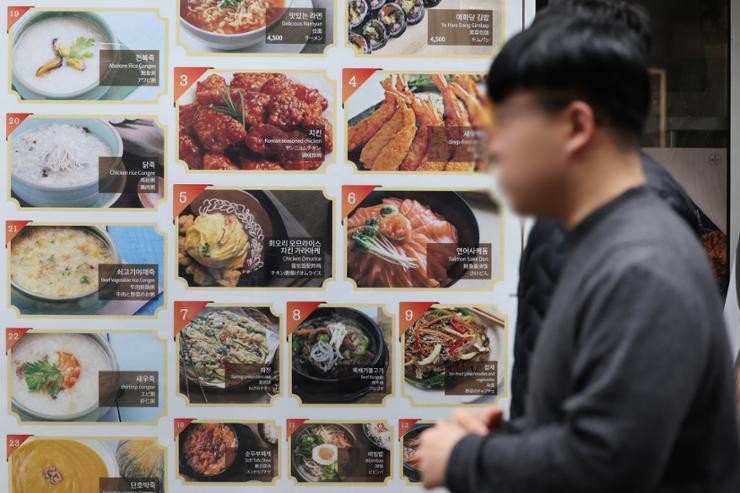
Inflation in Korea makes basic food items unaffordable for many
Latest
 |
| People walk past a restaurant's menu board on a street in Myeong-dong, Seoul, April 3. (Source:Yonhap) |
Prices of gimbap (seaweed rice rolls), hamburgers, coffee, and even side dishes - common food choices that people could enjoy without spending a lot of money - have been on the rise. The inflationary impact is broad and it remains uncertain how long the price hikes will continue.
Some of the country's most popular chains for gimbap, instant noodles, fast food and other affordable dishes have increased the prices of their popular meal items.
For example, TeacherKim raised its gimbap price from 4,300 won to 4,500 won. Gimgane increased the prices of its two popular gimbap menu items, from 3,900 won to 4,500 won and from 4,900 won to 5,500 won.
McDonald's, the most popular fast food restaurant chain here, made headlines earlier this month when it announced it will raise the prices of 16 products by 2.8 percent. The price of a Big Mac set rose from 6,900 won to 7,200 won and the McSpicy Shanghai burger from 6,900 won to 7,100 won. The prices of other burgers also rose by 200 won to 400 won. The brand also raised prices in November last year.
Fried chicken chains, the country's top choice for take-out or delivery, have raised prices more drastically. Goobne raised the prices of nine products by 1,900 won and Popeyes by up to 800 won. Kyochon F&B raised the price of its signature chicken menu from 20,000 to 23,000 won. Including the delivery charge, ordering a whole chicken now costs nearly 30,000 won for most local fried chicken vendors.
According to Statistics Korea, Tuesday, prices of the 39 most popular food items in the country – including tteokbokki, bibimbap, gimbap and hamburgers – increased by 3 percent on average last month.
The Korea Consumer Agency reported on Monday that eight all-time-favorite food items in Seoul displayed price increases of up to 7 percent in March compared to the same month last year.
Naengmyeon (cold noodles), one of the food items whose price has increased the most, rose 7.2 percent, and a bowl now costs 11,500 won on average. Upscale restaurants in Seoul have raised their naengmyeon prices by 1,000-2,000 won to 15,000-16,000 won per bowl.
Park Sung-joo, 41, a housewife with three young children, said her family used to eat fried chicken and other fast food, but they have now become unaffordable.
"Fried chicken or pizza used to be our favorite choices for meals when they cost around 20,000 won. Now, prices have gone up to 30,000 won to 40,000 won and we cannot afford them anymore," she said.
Park said she now cooks more often instead of dining out or having food delivered.
However, grocery shopping has become more expensive than before. Following the sharp rise in prices of fruits and other agricultural products earlier this year - including an over 80 percent increase in the price of apples - prices of other items are also steadily increasing.
Due to a cocoa price hike, Lotte Wellfood increased the prices of 17 of its confectionery and ice cream products by 12 percent. Additionally, a rise in the price of seaweed prompted Sung Gyung Food to raise the retail prices of its dried seaweed products by 10 percent last month. Kwangcheonkim also raised product prices by 15-20 percent.
Food company officials said unstable oil prices and a weak Korean won against the U.S. dollar have caused local food manufacturers to be hit by rising costs of ingredients, wages and logistics, forcing them to raise product prices.
















